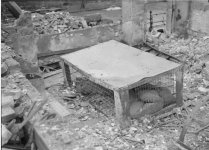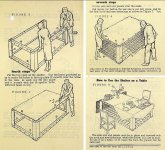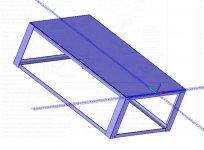I was at Sams club a few weeks ago and saw the huge piles of bottled water cases and thought that it could be used for radiation shielding, then drank after an event had passed.
I drew up several iterations of a support structure that could hold the waters weight and allow it to be set up in a spare bedroom or even a garage. A person could slip into a bed set up in the water shielding pile, and remain in place for the first 12 hours after fallout. They could make a fast run to the restroom and return after that timeframe for the next several days. They could make a fast run to the kitchen for a snack and return. Using fallout decay schedules they could figure out how long to stay in the shelter and could continue to sleep in it for months to minimize their exposure to remaining fallout, plus have lots of water to drink (No it does not become radioactive).
Last week I came across Canadian Prepper doing a short on Atlas shelters who mentioned the "Morrison shelter" It was almost exactly what I had been drawing. It was used in WWII in England to keep collapsing houses from crushing families during German bombing raids.
It is 6' 6" long x 4' with, 26" tall with a 1/8" steel sheet on the top and an angle iron frame. You put a mattress inside and sleep in it and hide in it when the air raid sirens sound.
I am considering manufacturing these with instructions to pile water cases (Or bags of sand, concrete, books etc..) on and around it for radiation shielding plus build a wall of such stuff in front of it, far enough away to allow the user to get in and out but would block radiation form going into the doorway. It would then be a fallout/bomb shelter for a minimum cost compared to digging up your yard and installing the minimum $20,000 to $250,000 shelter. Shipping would suck and they are still fairly heavy, probably 250-300 lbs when assembled.
Here is one intact inside of a bombed out house. They are bigger than you might think in the picture but you get the idea.
What say you all? Dumb idea? May sell? Nut job? Must have for a low dollar prepper?



I drew up several iterations of a support structure that could hold the waters weight and allow it to be set up in a spare bedroom or even a garage. A person could slip into a bed set up in the water shielding pile, and remain in place for the first 12 hours after fallout. They could make a fast run to the restroom and return after that timeframe for the next several days. They could make a fast run to the kitchen for a snack and return. Using fallout decay schedules they could figure out how long to stay in the shelter and could continue to sleep in it for months to minimize their exposure to remaining fallout, plus have lots of water to drink (No it does not become radioactive).
Last week I came across Canadian Prepper doing a short on Atlas shelters who mentioned the "Morrison shelter" It was almost exactly what I had been drawing. It was used in WWII in England to keep collapsing houses from crushing families during German bombing raids.
It is 6' 6" long x 4' with, 26" tall with a 1/8" steel sheet on the top and an angle iron frame. You put a mattress inside and sleep in it and hide in it when the air raid sirens sound.
I am considering manufacturing these with instructions to pile water cases (Or bags of sand, concrete, books etc..) on and around it for radiation shielding plus build a wall of such stuff in front of it, far enough away to allow the user to get in and out but would block radiation form going into the doorway. It would then be a fallout/bomb shelter for a minimum cost compared to digging up your yard and installing the minimum $20,000 to $250,000 shelter. Shipping would suck and they are still fairly heavy, probably 250-300 lbs when assembled.
Here is one intact inside of a bombed out house. They are bigger than you might think in the picture but you get the idea.
What say you all? Dumb idea? May sell? Nut job? Must have for a low dollar prepper?





